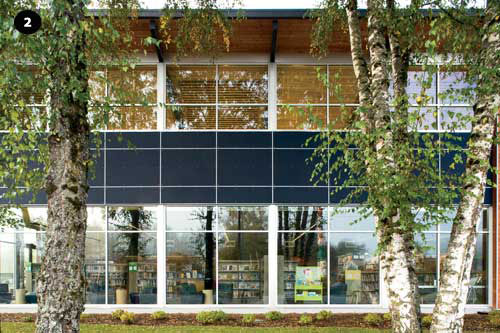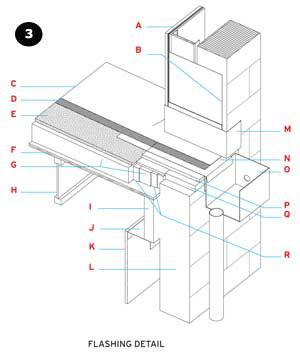Diving Into BIM
 |
Within the digital model, the architects created exterior shading studies (1) for key times of the year, such as the summer and winter solstices. The diagrams helped them better understand where they could place generously glazed facades (2) and still avoid annoying glare. With the model, the architects could identify potentially tricky areas early in the design process, such as the juncture of a concrete masonry wall and roof, and then study possible solutions (3). Photos: Miller Hull Partnership |
With the digital models, Miller Hull could perform basic environmental analyses, such as exterior shading diagrams for key times of the day and year. The studies helped the architects design the facades and size overhangs and windows in order to avoid interior glare conditions during the libraries' operating hours. The firm has since begun using additional BIM-compatible simulation tools to inform its early design decisions and perform solar and thermal analyses, evaluate ventilation and airflow characteristics, and create interior daylighting studies.
Across the libraries' team, the level of BIM deployment was not consistent. For instance, Miller Hull's consultants worked in 2D CAD. And at the start of the project, even BNB did not yet own BIM software. However, the architect was able to share the model with the design-builder as portable files known as 3D DWFs, or Design Web Format. BNB used these files primarily as visualization tools - to highlight different wall types, isolate the structure, or identify various components and assemblies, in order to explain the buildings to its own crews and its subcontractors, says Brian Wiersema, BNB's senior project engineer. Part way through the library projects, BNB obtained the software, allowing it to use the "live" BIM files to perform more sophisticated 4D and 5D construction planning tasks, such as calculating quantities of materials, creating animations illustrating the sequence of construction, and making detailed schedules.
According to Wiersema, the models would have been even more useful for the procurement and construction process had they included product-specific information, such as manufacturer names or hyperlinks to catalog cut sheets. But the software was still a bit too unfamiliar and the pace of the projects too fast to incorporate such a level of detail into the model, says Caramella.
Now, however, Miller Hull is regularly creating data-rich digital models. One example is the building information model for a much larger library for a different client. The model for the 85,000-square-foot facility under construction in downtown Vancouver, Washington, incorporates the number of books in the library's collections and their space requirements. In early design phases, the architects relied on this information to quickly evaluate the storage capacity of various schemes, ultimately using it to generate a shelving procurement schedule that includes quantities, dimensions, materials, and model information. If designers chose to change one characteristic, such as a product or size, all affected instances would be automatically updated in the model, explains Coates. In a typical 2D environment, these data reside in multiple locations, including drawings and spreadsheets, allowing more opportunity for the introduction of error, she adds.
Both Miller Hull and BNB say that as their BIM projects have become larger and more complex, and their utilization of the software's capabilities more advanced, and as more of the project team participates in the modeling process, management and organization of the digital model has become increasingly critical. For Revit, Caramella recommends subdividing the model to prevent it from becoming unwieldy and to facilitate multiuser collaboration. These subdivisions can be organized by building components, such as interior partitions, furniture, or lighting. Alternatively, they can be organized according to programmatic zones. For example, a research facility could be divided into a laboratory block and administrative wing. "That way, several users can work on the model simultaneously without stepping on each other's toes," he says. And to ensure consistency among its projects, Miller Hull has a document that outlines in-house modeling conventions and protocols.
Â
 |
|||
| Photo: © Yoram Bernet | |||
 |
|
||









